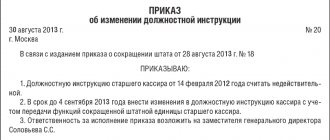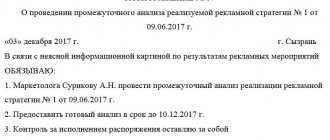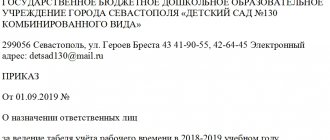Is it necessary to familiarize employees with the bonus regulations?
By law, the organization is obliged to familiarize the employee with local regulations if it affects his work activities.
Typically, this must be done when hiring a new employee to the organization, even before signing an employment contract with him. If changes are made to the document, then all company employees also need to be familiarized with the new version.
You can record the fact of familiarization in one of the following ways:
- By placing a signature on the regulatory act itself;
- Maintaining an introductory sheet for each act or one general one;
- Maintaining an introductory journal, the pages of which must be numbered and stitched.
Attention! There are no strict deadlines during which it is necessary to familiarize employees with the amended local act. In the case of the Regulations on bonuses, it is advisable to do this before the bonuses are accrued for the month worked.
Order on approval of instructions for office work
The legislation does not provide for a unified form of this order, so managers draw it up independently. However, there are recommendations on its content, developed in practice. It must necessarily contain:
- full and short name of the organization;
- document's name;
- registration number;
- publication date;
- title;
- text;
- signatures and visas of the manager and interested employees.
Other publications: Statement regarding noisy neighbors at night
The order includes information about the execution procedure, who controls it, as well as the scope of action. The introductory part justifies the need to publish the document and its purpose. For example, the phrase is used: “For the purpose of organizing work to comply with the procedure for conducting office work.” You can use another motivation, but after it indicate the name of the enterprise, as well as the word “I order.”
The text of the guarantee part can be divided into several paragraphs. The first contains direct instructions on the introduction of instructions. The second paragraph instructs to familiarize all interested employees with it. The third paragraph is devoted to specifying the person responsible for monitoring the execution of instructions. More often than not, the manager leaves this responsibility to himself. The order itself is accompanied by instructions, which should be noted in the first paragraph of the text, at the top of it. It is worth remembering that both documents must be kept together. A sample order for approval of office management instructions is presented below.
After the document is signed by the manager, it goes through the registration procedure, and copies of it are sent to all responsible employees along with the application. In addition, the staff must be familiar with the text of the act upon signature. For this purpose, a familiarization sheet can be drawn up or a log of familiarization of employees with local regulations can be used.
About the position
The creation of bonus regulations at the enterprise is carried out by specialists. The purpose of this document is to encourage employees to strive for greater performance.
This act can be drawn up in parallel with the Regulations on remuneration. Therefore, they can be put into effect with a single order.
After signing, the order is recorded in the order register. The provision itself usually comes as an annex to it. Therefore, when approved, the details of the order by which it was put into effect are indicated on the cover of the document.
You might be interested in:
Certificate 182n: what is it for, sample filling and form 2019
If in the process of carrying out activities it becomes necessary to make changes to the current regulations, a request for this is submitted as a memo to the manager. The new edition of the document is put into effect by a new order.
See an example of a sheet for familiarizing yourself with local regulations.
The procedure for developing instructions for office work
Existing legislation does not oblige enterprise managers to adopt this regulatory act. However, it has an important practical nature, since it allows you to optimize and streamline the algorithm for working with documents in an organization. Typically, the development of this document consists of several stages:
- Collection and analysis of information is carried out on the basis of a survey of department heads, as well as regulatory and methodological documentation.
- Preparing the text.
- Agreement with interested employees is recorded by drawing up an agreement sheet.
- Statement.
- Commissioning.
The instructions for office work are given legal force after the issuance of an order for its approval.
What documents are taken into account in the journal: specifics of orders for personnel
Orders for personnel are, as a rule, personalized - regulating the activities of specific employees or groups of them (for example, a department or service).
As we noted above, it is customary to classify as personnel orders only those local documents that apply to ordinary employees (not related to management in accordance with the charter). That is, for example, an order for the appointment of a general director or chief accountant should not be recorded in the journal in question.
Documents that can be included in the journal most often include orders:
- on hiring an employee;
- dismissal of an employee;
- transfer of an employee to another position;
- combination of employees;
- part-time employee;
- wages;
- business trip;
- vacation, maternity leave;
- awarding;
- changing the employee's full name.
The employer has the right to use the forms of personnel orders that it deems necessary to choose. But according to tradition, the use of unified forms is widespread in the Russian Federation, such as, for example:
- T-1 and T-1a (for issuing an order to hire an employee);
- T-8 and T-8a (for issuing a dismissal order);
- T-9 and T-9a (for issuing a business trip order).
Other publications: Average pension in the Murmansk region in 2019
These forms were approved by Decree of the State Statistics Committee of the Russian Federation dated January 5, 2004 No. 1.
Before registering a particular order for personnel and thus giving it legal force (if this is provided for by the rules of document flow), the personnel department employee must make sure that the order has the necessary signs of legitimacy, such as:
- the presence of a link to the document that is the basis for issuing the order (for example, an employment contract - if we are talking about an order for employment), a link to legal acts - if the norm established by the order corresponds with the provisions of the corresponding document or legal acts;
- presence of the name, date, number, place of preparation of the document;
- presence of a document title;
- availability of the text of the order;
- signature of the employer's manager;
- presence of a mark on the approval of the document by a lawyer or other competent employee.
For information on the document that is a source of additional information about the employee, read the article “Employment Questionnaire - Form and Sample.”
Forms of primary accounting documents and accounting registers have been updated
Since June 19, 2020, Order No. 52n of the Ministry of Finance of Russia dated March 30, 2015 has been in effect.
“On approval of forms of primary accounting documents and accounting registers...” (hereinafter referred to as order No. 52n). In this regard, the previously effective order No. 173n dated December 15, 2010 became invalid. Institutions must apply the provisions of the new document when developing accounting policies starting from 2015. However, there is no need to correct previously completed “primary statements” and registers. Let's figure out what changes the financial department has made.
What does order 52n contain?
The new document approved:
- list of unified forms of primary accounting documents (Appendix No. 1);
- forms of primary accounting documents (Appendix No. 2);
- list of accounting registers (Appendix No. 3);
- forms of accounting registers (Appendix No. 4);
- guidelines for the use of forms of primary accounting documents and the formation of accounting registers (Appendix No. 5).
For whom was order 52n approved?
Public sector institutions must use updated forms of primary accounting documents and accounting registers, as well as be guided by new guidelines for their application and completion. Order 52n also applies to:
- state (municipal) unitary enterprises when maintaining budget accounting (clause 7 of order No. 52n);
- State Atomic Energy Corporation Rosatom (when maintaining budgetary accounting) (clause 8 of order No. 52n).
At the same time, officials clarified that institutions must switch to using new forms and registers taking into account their organizational and technical readiness. Reason – letter of the Ministry of Finance dated June 10, 2020 No. 02-07-07/33768. Since the approval of such documents is a significant change in the rules of regulatory accounting.
Consequently, state and municipal institutions have the right to make adjustments to their accounting policies and in the future be guided by new provisions. And for this it is necessary to carry out a number of activities to apply the new requirements - providing institutions with new forms and training staff to work with them (if necessary).
Primary accounting documents
Let's consider what changes have affected the primary accounting forms for OKUD classes.
Class 03 OKUD
The number of documents in this class has decreased.
This is due to the expansion of the list of “primary documents” belonging to class 05 “Unified system of accounting, financial, accounting and reporting documentation of the public sector of management” OKUD by classifying documents previously included in class 03 “Unified system of primary accounting documentation” OKUD. Now public sector institutions must use only the following forms:
- form 0310001 – cash receipt order;
- form 0310002 - expense cash order;
- form 0310003 – journal of registration of incoming and outgoing cash documents;
- form 0310005 – book of accounting of funds accepted and issued by the cashier (new document).
Please note that the rules that must be followed when maintaining cash documents are regulated by Directive of the Central Bank of the Russian Federation dated March 11, 2014 No. 3210-U.
Class 04 OKUD
As for the forms of primary accounting documents of class 04 OKUD, a new form 0401071 (Collection order) has been added to those previously used. So there are now three documents in this class. In addition to the above, these are:
- payment order (f. 0401060);
- announcement for cash payment (f. 0402001).
Class 05 OKUD
Some forms of primary accounting documents of class 03 OKUD have been combined. In this regard, the following are now applied:
- form 0504101 – act of acceptance and transfer of non-financial assets (combined three previously used forms - 0306030 (act of acceptance and transfer of a building (structure)), 0306031 (act of acceptance and transfer of groups of fixed assets (except buildings, structures)), 0306001 (act of acceptance and transfer of fixed assets (except for buildings, structures));
- form 0504104 - act on write-off of non-financial assets (except vehicles)) (combined two previously used forms - 0306003 (act on write-off of fixed assets (except motor vehicles)) and 0306033 (act on write-off of groups of fixed assets (except motor vehicles) ))).
For other forms of “primary”, only the code or name has changed, or both. For clarity, we present the names and codes of new and old forms in the table.
Order No. 52n Order No. 173n
| Form number | Form name | Form number | Form name |
| 0504102 | Invoice for internal movement of non-financial assets | 0305032 | Invoice for internal movement of fixed assets |
| 0504103 | Certificate of acceptance and delivery of repaired, reconstructed and modernized fixed assets | 0306002 | Certificate of acceptance and delivery of repaired, reconstructed, modernized fixed assets |
| 0504105 | Certificate of write-off of a vehicle | 0306004 | Act on write-off of motor vehicles |
| 0504204 | Request-invoice | 0315006 | Request-invoice |
| 0504205 | Invoice for the release of materials (material assets) to the side | 0315007 | Invoice for issue of materials to the side |
| 0504220 | Certificate of acceptance of materials (material assets) | 0315004 | Certificate of acceptance of materials |
| 0504402 | Payslip | 0301010 | Payslip |
| 0504421 | Time sheet | 0504421 | Time sheet and payroll calculation |
| 0504505 | Advance report | 0504049 | Advance report |
| 0504833 | Accounting information | 0504833 | Reference |
Please note: previously the expense report belonged to the accounting registers. The list of documents of class 05 of order No. 52n does not include:
- form 0531728 (acceptance and transfer certificate of cash payments and receipts during the reorganization of participants in the budget process);
- form 0531811 (certificate of financing and cash payments).
But such documents as a card (book) for recording the issuance of property for use (f. 0504206) and a receipt order for the acceptance of material assets (non-financial assets) (f. 0504207), on the contrary, have been added.
Thus, the approval of form 0504206 is associated with the introduction of off-balance sheet account 27 “Material assets issued for personal use to employees (employees)” (Order of the Ministry of Finance of Russia dated August 29, 2014 No. 89n).
This account reflects inventories that have a standard service life (socks), issued for personal (individual) use to workers (employees) for the performance of their official (official) duties. Such stocks include special clothing or shoes, uniforms, clothing, clothing and footwear, as well as sports clothing and footwear, etc.
But the following forms (their codes and names) remain the same:
- act on write-off of soft and household equipment (f. 0504143);
- act on the write-off of excluded objects of the library collection (f. 0504144);
- menu-requirement for issuing food products (f. 0504202);
- statement for the issuance of feed and fodder (f. 0504203);
- statement of issuance of material assets for the needs of the institution (f. 0504210);
- act on write-off of inventories (f. 0504230);
- payroll statement (f. 0504401);
- payroll (f. 05044403);
- reference card (f. 0504417);
- note-calculation on the calculation of average earnings when granting leave, dismissal and other cases (f. 0504425);
- statement for the issuance of money from the cash register to accountable persons (f. 0504501);
- receipt (f. 0504510);
- cash book (f. 0504514);
- children's attendance sheet (f. 0504608);
- notice (0504805);
- act on the write-off of strict reporting forms (f. 0504816);
- notification on settlements between budgets (f. 0504817);
- notification of limits on budget obligations (budget allocations) (f. 0504822);
- act on the results of the inventory (f. 0504835).
Accounting registers
The list of previously used accounting registers has not been adjusted much. It did not include:
- consolidated register of receipts and disposals - form 0531455;
- statement of accounting for outstanding receipts - form 0531456.
The name of form 0504031 has also been changed. Previously it was called an inventory card for accounting for fixed assets, and now it is called an inventory card for accounting for non-financial assets.
What changes have been made to the instructions for filling out primary forms and accounting registers?
Amendments have been made to the guidelines for the use of primary accounting documents and accounting registers. Here are some of them.
- Institutions have the right to include additional details (data) in the primary (consolidated) accounting document generated on the basis of a unified document form. The goal is to ensure the completeness of reflection in accounting of information about assets, liabilities and facts of economic life that change them. In this case, the condition on the safety of the mandatory details and indicators provided for in the document forms must be observed.
- Primary accounting documents and accounting registers compiled in electronic form must be signed with a qualified electronic signature. But they can be kept on paper in the following cases:
- if the institution does not have the ability to generate documents and store them in electronic form;
- if federal laws or regulations adopted in accordance with them establish a requirement for the need to compile (storage) a document exclusively on paper.
Source: https://www.budgetnik.ru/art/3696-red-obnovleny-formy-pervichnyh-uchetnyh-dokumentov-i-registrov-ucheta







